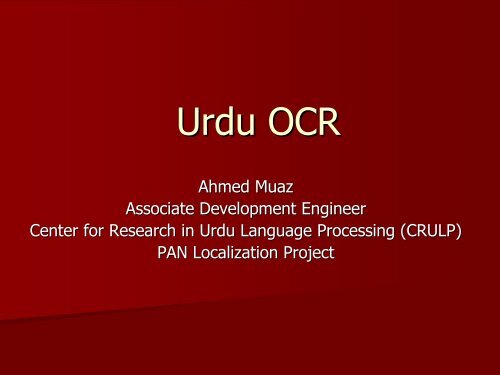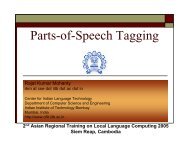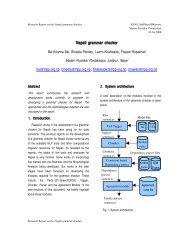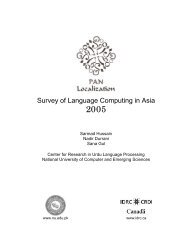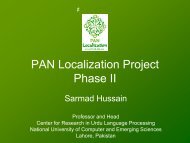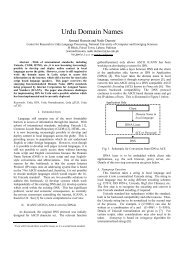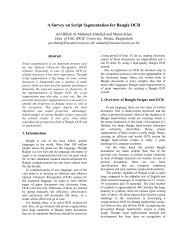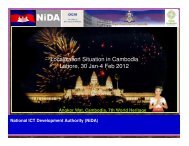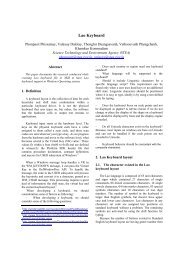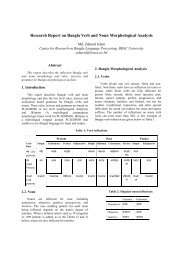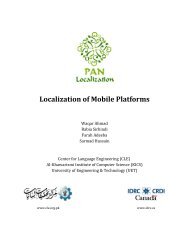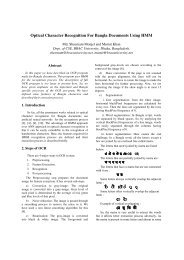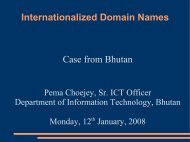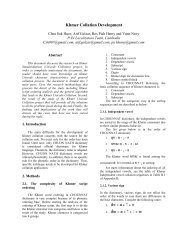Urdu OCR - PAN Localization
Urdu OCR - PAN Localization
Urdu OCR - PAN Localization
Create successful ePaper yourself
Turn your PDF publications into a flip-book with our unique Google optimized e-Paper software.
<strong>Urdu</strong> <strong>OCR</strong><br />
Ahmed Muaz<br />
Associate Development Engineer<br />
Center for Research in <strong>Urdu</strong> Language Processing (CRULP)<br />
<strong>PAN</strong> <strong>Localization</strong> Project
<strong>Urdu</strong><br />
• Written in Arabic script from right to left<br />
• Bidirectional nature<br />
– Numbers are written from left to right<br />
• 37 characters in <strong>Urdu</strong> Alphabet<br />
– Diacritical marks<br />
• Most of the printed material is in<br />
“Nastaleeq” writing style/script<br />
2
Character set and Classification<br />
• 21 classes<br />
3
Properties of Nastaleeq Script<br />
• Diagonally written with stacking of Characters<br />
• Hidden baseline<br />
4
Properties of Nastaleeq Script<br />
• Joining<br />
• shape conversion<br />
– Depends on next characters<br />
• Up to 45 shapes<br />
• Overlapping<br />
– Within Ligature<br />
– Among ligatures<br />
5
Properties of Nastaleeq Script<br />
• Diacritic re-placement during joining process<br />
• Shifting with addition of every character<br />
6
<strong>Urdu</strong> <strong>OCR</strong> development<br />
• Scope of current research<br />
– Noori Nastaleeq<br />
– Font size 36 Point<br />
– Scanned at 300 DPI<br />
7
<strong>Urdu</strong> <strong>OCR</strong> Design<br />
8
Segmentation Preprocessing<br />
• Separate lines<br />
– Vertical Histogram<br />
• Set Base Line<br />
– At maximum Intensity<br />
• Main body Isolation<br />
– Attached to baseline<br />
9
Segmentation I<br />
• Skeletanization<br />
(Thinning)<br />
– Jang Chin Masking<br />
Algorithm<br />
• Starting point<br />
– Find all free points<br />
– Leftmost from bottom to top<br />
• Chain code traversal<br />
• Segmentation point<br />
– Stroke Junction<br />
10
Segmentation II<br />
• Cutting<br />
– At segmentation point<br />
– Ordered from right to<br />
left, top to bottom<br />
3<br />
2<br />
1<br />
• Thickening<br />
– Restoration of original shapes<br />
– Cutting original ligature along<br />
with segmented stroke<br />
11
Framing<br />
• Divide segment in equal<br />
sized windows<br />
• Sliding window framing<br />
– 15*15 pixel frame<br />
– Overlapped<br />
– Sliding along thin stroke<br />
• Frames are numbered according to their<br />
position<br />
• Discrete Cosine Transformation<br />
12
Recognition and Post processing<br />
• Recognition System<br />
– Hidden Markov Model<br />
– Used HTK for training HMM<br />
– Frames are used as states of HMM<br />
– The highest probable HMM ID is returned<br />
• Post Processing<br />
– Deterministic Automata to get character ID<br />
– Rule file for construction of Ligatures<br />
13
Training Data Population<br />
• Class based incremental training<br />
– Generating combinations of characters<br />
– Adding more classes to cover more ligatures<br />
• Ligatures for training were taken out of 46K<br />
words clean corpus<br />
• 13,628 unique ligatures<br />
• Only 3,184 ligatures are frequent<br />
• Used 30 samples per ligature<br />
14
Current Status<br />
• We have trained 13 classes (29 Characters)<br />
• That covers 1,367 frequent Ligatures<br />
• There are 376 segments trained<br />
• Accuracy for different classes<br />
15
Challenges<br />
• Various shapes of same character<br />
• Humongous training data<br />
– Addition of on new class adds 150-200 Ligatures<br />
– Total ligatures 5,000-6,000<br />
– That yields segments 20-30K<br />
• Clustering of segments for training<br />
– New clusters<br />
– Matching with already trained clusters<br />
• Over and under segmentation<br />
– Variation in the shape of ligature can cause<br />
change in thinning and hence segmentation is<br />
affected<br />
16
Future Work<br />
• Diacritic association<br />
– Improvement in recognition<br />
– Character identification from class ID<br />
• Development of (Semi) automatic training<br />
system<br />
• Improvement in Segmentation Algorithm<br />
• Preprocessing engine<br />
17
Thank you<br />
Suggestions/Comments<br />
Questions<br />
18


